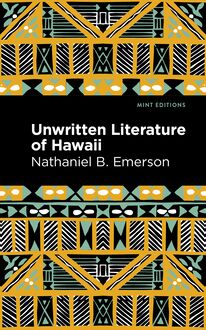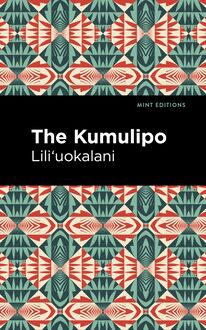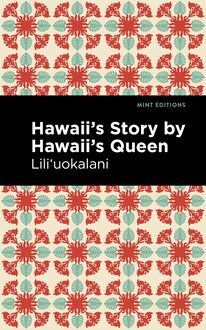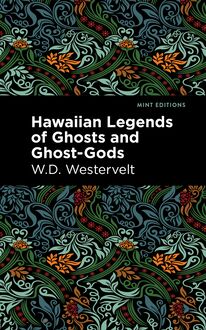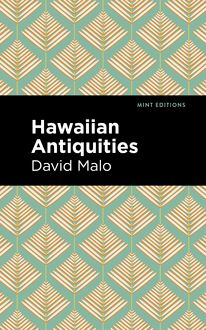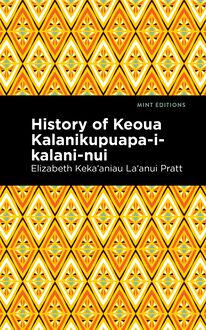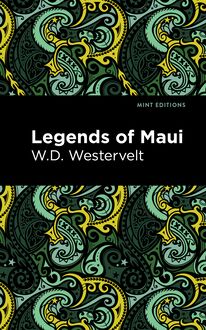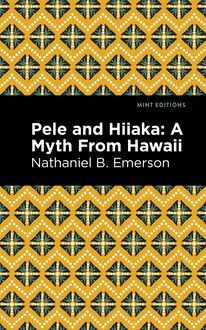-
 Univers
Univers
-
 Ebooks
Ebooks
-
 Livres audio
Livres audio
-
 Presse
Presse
-
 Podcasts
Podcasts
-
 BD
BD
-
 Documents
Documents
-
- Cours
- Révisions
- Ressources pédagogiques
- Sciences de l’éducation
- Manuels scolaires
- Langues
- Travaux de classe
- Annales de BEP
- Etudes supérieures
- Maternelle et primaire
- Fiches de lecture
- Orientation scolaire
- Méthodologie
- Corrigés de devoir
- Annales d’examens et concours
- Annales du bac
- Annales du brevet
- Rapports de stage
La lecture à portée de main
Vous pourrez modifier la taille du texte de cet ouvrage
Découvre YouScribe en t'inscrivant gratuitement
Je m'inscrisDécouvre YouScribe en t'inscrivant gratuitement
Je m'inscrisEn savoir plus
Vous pourrez modifier la taille du texte de cet ouvrage
En savoir plus

Description
Hawaiian Antiquities (1898) is an ethnography by David Malo. Originally published in 1838, Hawaiian Antiquities, or Moolelo Hawaii, was updated through the end of Malo’s life and later translated into English by Nathaniel Bright Emerson, a leading scholar of Hawaiian mythology. As the culmination of Malo’s research on Hawaiian history, overseen by missionary Sheldon Dibble, Hawaiian Antiquities was the first in-depth written history of the islands and its people. “The ancients left no records of the lands of their birth, of what people drove them out, who were their guides and leaders, of the canoes that transported them, what lands they visited in their wanderings, and what gods they worshipped. Certain oral traditions do, however, give us the names of the idols of our ancestors.” As inheritor of this ancient oral tradition, David Malo, a recent Christian convert who studied reading and writing with missionaries, provides an essential introduction to the genealogies, history, traditions, and stories of his people. Engaging with the legends passed down from ancient generations as well as the flora and fauna of the islands in his own day, Malo links the Hawaii of the past to the world in which he lived, a time of political and religious change introduced by missionaries from the newly formed United States. With a beautifully designed cover and professionally typeset manuscript, this edition of David Malo’s Hawaiian Antiquities is a classic work of Hawaiian literature reimagined for modern readers.
Sujets
Informations
| Publié par | Mint Editions |
| Date de parution | 03 août 2021 |
| Nombre de lectures | 0 |
| EAN13 | 9781513223872 |
| Langue | English |
| Poids de l'ouvrage | 3 Mo |
Informations légales : prix de location à la page 0,0500€. Cette information est donnée uniquement à titre indicatif conformément à la législation en vigueur.
Extrait
Hawaiian Antiquities
(Moolelo Hawaii)
David Malo
Hawaiian Antiquities was first published in 1898.
This edition published by Mint Editions 2021.
ISBN 9781513299532 | E-ISBN 9781513223872
Published by Mint Editions®
MintEditionBooks.com
Publishing Director: Jennifer Newens
Design & Production: Rachel Lopez Metzger
Project Manager: Micaela Clark
Translated By: Dr. N.B. Emerson
Typesetting: Westchester Publishing Services
To
Bernice Pauabi Bishop
The Mother of Hawaiian Industrial Education
I Dedicate this Volume in appreciation of her efforts to keep alive a knowledge of the Antiquities and Mysteries of Hawaiian History
C ONTENTS L IST OF I LLUSTRATIONS B IOGRAPHICAL S KETCH OF D AVID M ALO P REFACE BY THE A UTHOR I NTRODUCTION BY W.D. A LEXANDER I. G ENERAL R EMARKS ON H AWAIIAN H ISTORY II. F ORMATION OF THE L AND III. T HE O RIGIN OF THE P RIMITIVE I NHABITANTS OF H AWAII NEI IV. O F THE G ENERATIONS D ESCENDED FROM W AKEA V. N AMES G IVEN TO D IRECTIONS OR THE P OINTS OF THE C OMPASS VI. T ERMS U SED TO D ESIGNATE S PACE A BOVE AND B ELOW VII. N ATURAL AND A RTIFICIAL D IVISIONS OF THE L AND VIII. C ONCERNING THE R OCKS IX. P LANTS AND T REES X. D IVISIONS OF THE O CEAN XI. E ATING U NDER THE K APU S YSTEM XII. T HE D IVISIONS OF THE Y EAR XIII. T HE D OMESTIC AND W ILD A NIMALS XIV. A RTICLES OF F OOD AND D RINK IN H AWAII XV. T HE F ISHES XVI. T HE T APAS , M ALOS , P AUS AND M ATS OF THE H AWAIIANS XVII. T HE S TONE A X AND THE N EW A X XVIII. T HE A LIIS AND THE C OMMON P EOPLE XIX. L IFE IN THE O UT -D ISTRICTS AND AT THE K ING ’ S R ESIDENCE XX. C ONCERNING K AUWA XXI. W RONG C ONDUCT AND R IGHT C ONDUCT XXII. T HE V ALUABLES AND P OSSESSIONS OF THE A NCIENT H AWAIIANS XXIII. T HE W ORSHIP OF I DOLS XXIV. R ELIGIOUS O BSERVANCES R ELATING TO C HILDREN XXV. C ONCERNING THE C IRCUMCISION OF C HILDREN XXVI. R ELIGIOUS W ORSHIP FOR H EALING OF THE S ICK XXVII. C ONCERNING D EAD B ODIES XXVIII. C ONCERNING THE C EREMONY OF K UNI XXIX. C ONCERNING THE C EREMONIES ON THE D EATH OF A K ING XXX. T HE M EDICAL T REATMENT OF THE S ICK XXXI. N ECROMANCY XXXII. C ONCERNING O BSESSION (A KUA N OHO ) XXXIII. T HE H OUSE —I TS F URNITURE AND I TS C ONSECRATION XXXIV. T HE H AWAIIAN C ANOE XXXV. R ELIGIOUS C EREMONIES P ERFORMED BY THE A LIIS FOR S ECURE O FF -S PRING XXXVI. C ONCERNING THE M AKAHIKI XXXVII. C ONCERNING THE L UAKINI XXXVIII. T HE C IVIL P OLITY XXXIX. A GRICULTURE XL. C ONCERNING F ISHING XLI. S PORTS AND G AMES , U ME XLII. S PORTS AND G AMES (K ILU ) XLIII. P UHENEHENE , OR P A -P UHENE XLIV. K UKINI —R UNNING F OOT -R ACES XLV. T HE G AME OF M AIKA XLVI. T HE G AME OF P AHEE XLVII. C ANOE -R ACING XLVIII. H E ’ E - NALU , S URF -R IDING XLIX. H OLUA -S LEDDING L. N OA LI. P UKAULA , J UGGLING LII. P A -P UA , OR K EA -P UA LIII. H OO -H AKA -M OA , C OCK -F IGHTING LIV. T HE H ULA LV. M OKOMOKO OR B OXING LVI. H AKOKO —W RESTLING LVII. S UNDRY M INOR S PORTS LVIII. T HE F LOOD LIX. T RADITIONS R EGARDING THE A NCIENT K INGS LX. H ALOA , THE S ON OF W AKEA LXI. W AIA , THE S ON OF H ALOA LXII. K APAWA LXIII. K ALAPANA LXIV. K ALAUNUIOHUA LXV. K AUHOLANUIMAHU LXVI. L ILOA LXVII. U MI
L IST OF I LLUSTRATIONS
1 . I NTERIOR V IEW OF C ABLE OF H AWAIIAN H OUSE
2 . T ENON AND MORTISE JOINING RAFTERS , O’A, OF ROOF TO THE UPRIGHTS , POU, OF THE SIDE OF THE HOUSE , ALSO RIDGEPOLE , IN SECTION
3 . M ANU , FIGURE - HEAD OF C ANOE , ORDINARY STYLE
4 . L ELE - IWI , FIGURE - HEAD SOMETIMES USED FOR DISPLAY
5 . T HE M AKAHIKI I DOL OR A KUA LOA
6 . M ARKS ON THE FACE INDICATING A K AUWA RANK
B IOGRAPHICAL S KETCH OF D AVID M ALO
I t is a commentary on the fleeting character of fame and human distinction that, even at this short remove from the life of one of Hawaii’s most distinguished sons, it is with no little difficulty that one can obtain correct data as to the details of his career; it is also an index of the rapidity with which the plough-share of evolution has obliterated old landmarks.
The materials from which this sketch of David Malo’s life is pieced together have been derived from many sources, both oral and written, as will be indicated in the course of the narrative.
Malo was the son of Aoao and his wife Heone, and was born at the seaside town of Keauhou, North Kona, Hawaii, not many miles distant from the historic bay of Kealakeakua, where Captain Cook, only a few years before, had come to his death. The exact year of his birth cannot be fixed, but it was about 1793, the period of Vancouver’s second visit to the islands. It was the time of a breathing spell in the struggle for military and political supremacy over the entire group in which the chief actors were Kahekili, the old war-horse and veteran of Maui, Kalanikupule, his son, the weak and ill-fated king of Oahu, and Kamehameha, the oncoming conqueror of the group.
Aoao, the father, was attached as a follower in some capacity to the court and army of Kamehameha and moved west with the tide of invasion; but I have found no evidence that his travels took him so far as Oahu, which was the western limit of his master’s operations.
During his early life Malo was connected with the high chief Kuakini (Governor Adams), who was a brother of Queen Kaahu-manu, and it was during this period specially that he was placed in an environment the most favorable to forming an intimate acquaintance with the history, traditions, legends and myths of old Hawaii, as well as with the meles, pules and oils that belong to the hula and that form so important and prominent a feature in the poesy and unwritten literature of Hawaii. But his attainments in these directions are even more to be ascribed to his happy endowment with a shrewd and inquiring mind as well as a tenacious memory, which had to serve in the place of writing and of all mnemonic tablets. If we may trust the authority of the writer of a brief sketch of Malo (See The Polynesian of Nov. 5, 1853), it was largely from association with one Auwai, a favorite chief of Kamehameha I, who excelled in knowledge of Hawaiian lore, including an acquaintance with the genealogies (kuauhau) of the chiefs, the religious ceremonials under the tabu system, and the old myths and traditions, that Malo was enabled to acquire his knowledge of these matters. In ancient Hawaii it was at the king’s court that were gathered the notable bards, poets, and those in whose minds were stored the traditional lore of the nation.
Brought up under circumstances well fitted to saturate his mind with the old forms of thought and feeling, it would be surprising if he had not at some time given evidence of ability in that form of composition, the mele, which represents the highest literary attainment of the old regime. Such a production by him we have,—a threnody celebrating the death of the beloved regent, Queen Kaahumanu, who died June 5, 1832. It is entitled, He Kanikau no Kaahumanu, a poem of real merit that combines in itself a large measure of the mystery of ancient pagan allusions with a tincture of such feelings as belong to one newly introduced to the stand-point of a Christian civilization. (A copy of this poem will be found in The Friend of Aug., 1859, together with a translation by C. J. Lyons.)
Such good use did Malo make of his opportunities that he came to be universally regarded as the great authority and repository of Hawaiian lore.
As a natural result of his proficiency in these matters, Malo came to be in great demand as a raconteur of the old-time traditions, meles, and genealogies, as a master in the arrangement of the hula, as well as of the nobler sports of the Hawaiian arena, a person of no little importance about court. In after years, when his mind had been impregnated with the vivifying influence of the new faith from across the ocean, his affections were so entirely turned against the whole system, not only of idol-worship, but all the entertainments of song, dance and sport as well, that his judgment seems often to be warped, causing him to confound together the evil and the good, the innocent and the guilty, the harmless and the depraved in one sweeping condemnation, thus constraining him to put under the ban of his reprobation things which a more enlightened judgment would have tolerated or even taken innocent pleasure in, or to cover with the veil of contemptuous silence matters, which, if preserved, would now be of inestimable value and interest to the ethnologist, the historian and the scholar.
It is a matter of vain regret from the stand-point of the student that this should have been the case, and that there should not have survived in him a greater toleration for the beauties and sublimities, as well as the darker mysteries, of that unwritten literature, which the student of today finds dimly shadowed in the cast-off systems of heathendom. But it is not to be wondered at that David Malo should have been unable to appreciate at its true value the lore of which he was one of the few repositories. It could be expected only of a foreign and broadly cultivated mind to occupy the stand-point necessary to such an appraisal. The basis of this criticism will be evident to every attentive reader of this book.
The attitude of David Malo’s mind toward the system of thought - from which he was delivered, “the pit from which he was digged,” as some would put it, was, from the circumstances of the case, one of complete alienation not to say intolerance, and gives ground for the generalization that it is hopleless to expect a recent convert to occupy a positon of judicial fairness to the system of religion and thought from which he has been rescued. While this may be reckoned as a tribute to the depth and sincerity of his nature, it cannot but be deemed an index of the necessarily somewhat narrow view of the mystic and the convert. The application of Malo’s energies to the task of setting forth in an orderly manner his knowledge of the history and antiq
-
 Univers
Univers
-
 Ebooks
Ebooks
-
 Livres audio
Livres audio
-
 Presse
Presse
-
 Podcasts
Podcasts
-
 BD
BD
-
 Documents
Documents
-
Jeunesse
-
Littérature
-
Ressources professionnelles
-
Santé et bien-être
-
Savoirs
-
Education
-
Loisirs et hobbies
-
Art, musique et cinéma
-
Actualité et débat de société
-
Jeunesse
-
Littérature
-
Ressources professionnelles
-
Santé et bien-être
-
Savoirs
-
Education
-
Loisirs et hobbies
-
Art, musique et cinéma
-
Actualité et débat de société
-
Actualités
-
Lifestyle
-
Presse jeunesse
-
Presse professionnelle
-
Pratique
-
Presse sportive
-
Presse internationale
-
Culture & Médias
-
Action et Aventures
-
Science-fiction et Fantasy
-
Société
-
Jeunesse
-
Littérature
-
Ressources professionnelles
-
Santé et bien-être
-
Savoirs
-
Education
-
Loisirs et hobbies
-
Art, musique et cinéma
-
Actualité et débat de société
- Cours
- Révisions
- Ressources pédagogiques
- Sciences de l’éducation
- Manuels scolaires
- Langues
- Travaux de classe
- Annales de BEP
- Etudes supérieures
- Maternelle et primaire
- Fiches de lecture
- Orientation scolaire
- Méthodologie
- Corrigés de devoir
- Annales d’examens et concours
- Annales du bac
- Annales du brevet
- Rapports de stage
